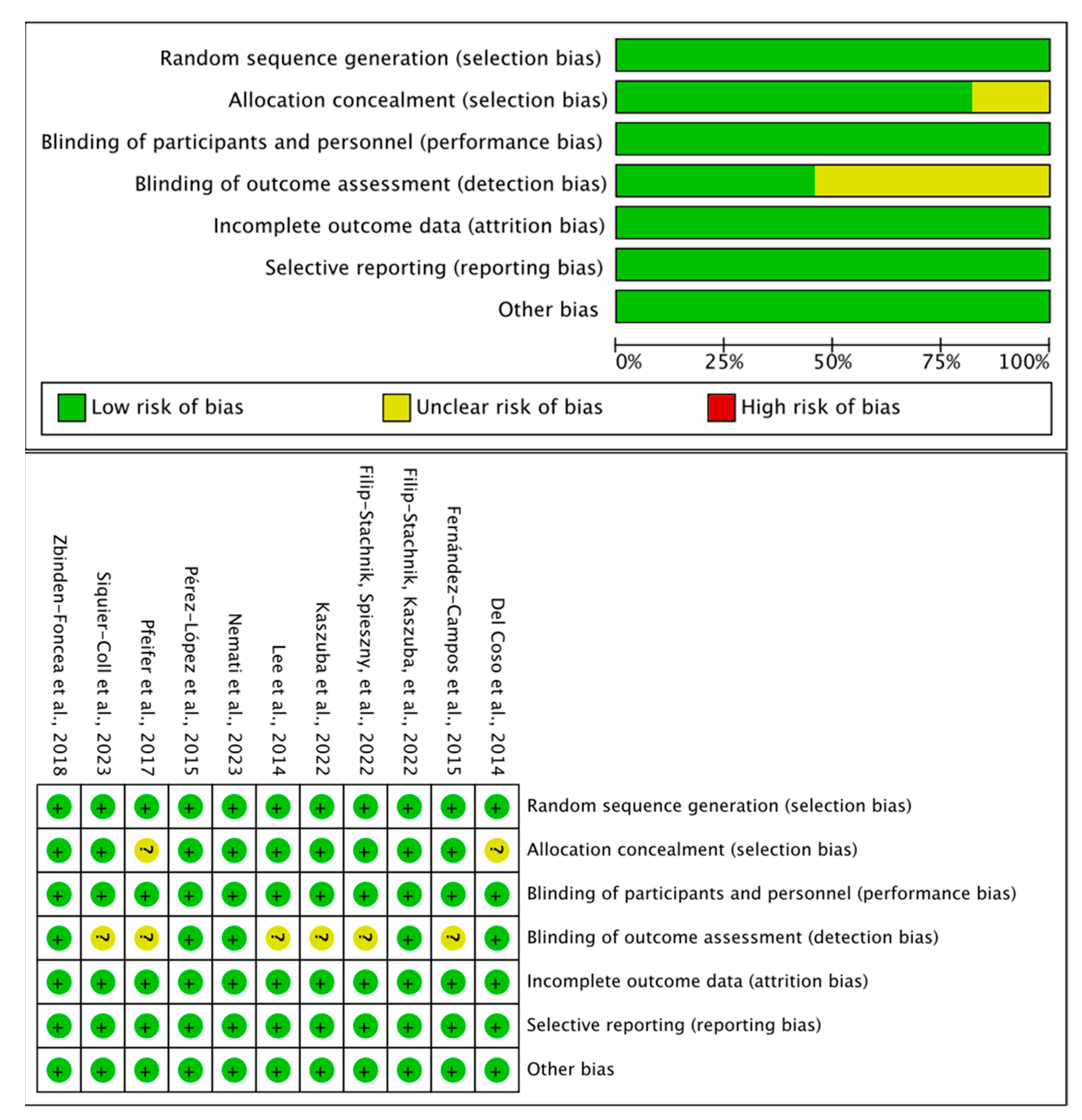Effects of Caffeine Supplementation on Exercise Performance in Volleyball Players: A Systematic Review and Meta-Analysis
Abstract
1. Introduction
2. Materials and Methods
2.1. Literature Search
2.2. Study Selection
2.3. Data Extraction
2.4. Assessment of Methodological Quality
2.5. Statistical Analyses
3. Results
3.1. Study Characteristics
3.2. Methodological Quality
3.3. Meta-Analysis Results
3.3.1. Volleyball-Specific Outcomes
3.3.2. Nonspecific Outcomes
3.3.3. Outcomes During Simulated Volleyball Competition
4. Discussion
4.1. Key Findings
4.2. Effects of Caffeine Supplementation on Volleyball-Specific and Nonspecific Performance
4.3. Effects of Caffeine Supplementation on Game Actions During Volleyball Competition
Limitations
5. Conclusions
Author Contributions
Funding
Data Availability Statement
Conflicts of Interest
References
- Verhagen, E.; Van der Beek, A.J.; Bouter, L.M.; Bahr, R.; Van Mechelen, W. A one season prospective cohort study of volleyball injuries. Br. J. Sports Med. 2004, 38, 477–481. [Google Scholar] [CrossRef]
- García-de-Alcaraz, A.; Ramírez-Campillo, R.; Rivera-Rodríguez, M.; Romero-Moraleda, B. Analysis of jump load during a volleyball season in terms of player role. J. Sci. Med. Sport 2020, 23, 973–978. [Google Scholar] [CrossRef] [PubMed]
- Sheppard, J.; Newton, R.; McGuigan, M. The effect of accentuated eccentric load on jump kinetics in high-performance volleyball players. Int. J. Sports Sci. Coach. 2007, 2, 267–273. [Google Scholar] [CrossRef]
- Sheppard, J.M.; Cronin, J.B.; Gabbett, T.J.; McGuigan, M.R.; Etxebarria, N.; Newton, R.U. Relative importance of strength, power, and anthropometric measures to jump performance of elite volleyball players. J. Strength Cond. Res. 2008, 22, 758–765. [Google Scholar] [CrossRef]
- Del Coso, J.; Muñoz, G.; Muñoz-Guerra, J. Prevalence of caffeine use in elite athletes following its removal from the World Anti-Doping Agency list of banned substances. Appl. Physiol. Nutr. Metab.=Physiol. Appl. Nutr. Metab. 2011, 36, 555–561. [Google Scholar] [CrossRef]
- Southward, K.; Rutherfurd-Markwick, K.J.; Ali, A. The Effect of Acute Caffeine Ingestion on Endurance Performance: A Systematic Review and Meta-Analysis. Sports Med. 2018, 48, 1913–1928. [Google Scholar] [CrossRef]
- Cao, Y.; He, W.; Ding, L.; Lei, T.-H.; Schlader, Z.; Mundel, T.; Wang, R.; Guo, L.; Liu, J.; Girard, O. Dose–response effects of caffeine during repeated cycling sprints in normobaric hypoxia to exhaustion. Eur. J. Appl. Physiol. 2025, 125, 223–236. [Google Scholar] [CrossRef]
- Kerksick, C.M.; Wilborn, C.D.; Roberts, M.D.; Smith-Ryan, A.; Kleiner, S.M.; Jäger, R.; Collins, R.; Cooke, M.; Davis, J.N.; Galvan, E. ISSN exercise & sports nutrition review update: Research & recommendations. J. Int. Soc. Sports Nutr. 2018, 15, 1–57. [Google Scholar]
- Grgic, J.; Grgic, I.; Pickering, C.; Schoenfeld, B.J.; Bishop, D.J.; Pedisic, Z. Wake up and smell the coffee: Caffeine supplementation and exercise performance-an umbrella review of 21 published meta-analyses. Br. J. Sports Med. 2020, 54, 681–688. [Google Scholar] [CrossRef]
- Chen, B.; Ding, L.; Qin, Q.; Lei, T.H.; Girard, O.; Cao, Y. Effect of caffeine ingestion on time trial performance in cyclists: A systematic review and meta-analysis. J. Int. Soc. Sports Nutr. 2024, 21, 2363789. [Google Scholar] [CrossRef]
- Grgic, J.; Trexler, E.T.; Lazinica, B.; Pedisic, Z. Effects of caffeine intake on muscle strength and power: A systematic review and meta-analysis. J. Int. Soc. Sports Nutr. 2018, 15, 1–10. [Google Scholar] [CrossRef] [PubMed]
- Ding, L.; Liu, J.; Yao, Y.; Guo, L.; Chen, B.; Cao, Y.; Girard, O. Caffeinated chewing gum enhances maximal strength and muscular endurance during bench press and back squat exercises in resistancetrained men. Front. Nutr. 2025, 12, 1540552. [Google Scholar] [CrossRef] [PubMed]
- Davis, J.M.; Zhao, Z.; Stock, H.S.; Mehl, K.A.; Buggy, J.; Hand, G.A. Central nervous system effects of caffeine and adenosine on fatigue. Am. J. Physiol. Regul. Integr. Comp. Physiol. 2003, 284, R399–R404. [Google Scholar] [CrossRef]
- Graham, T.E.; Spriet, L.L. Metabolic, catecholamine, and exercise performance responses to various doses of caffeine. J. Appl. Physiol. 1995, 78, 867–874. [Google Scholar] [CrossRef]
- Grgic, J. Caffeine ingestion enhances Wingate performance: A meta-analysis. Eur. J. Sport Sci. 2018, 18, 219–225. [Google Scholar] [CrossRef]
- Grgic, J. Effects of Caffeine on Resistance Exercise: A Review of Recent Research. Sports Med. 2021, 51, 2281–2298. [Google Scholar] [CrossRef]
- Salinero, J.J.; Lara, B.; Del Coso, J. Effects of acute ingestion of caffeine on team sports performance: A systematic review and meta-analysis. Res. Sports Med. 2019, 27, 238–256. [Google Scholar] [CrossRef]
- Diaz-Lara, J.; Nieto-Acevedo, R.; Abian-Vicen, J.; Del Coso, J. Can Caffeine Change the Game? Effects of Acute Caffeine Intake on Specific Performance in Intermittent Sports During Competition: A Systematic Review and Meta-Analysis. Int. J. Sports Physiol. Perform. 2024, 19, 1180–1196. [Google Scholar] [CrossRef]
- Page, M.J.; McKenzie, J.E.; Bossuyt, P.M.; Boutron, I.; Hoffmann, T.C.; Mulrow, C.D.; Shamseer, L.; Tetzlaff, J.M.; Akl, E.A.; Brennan, S.E.; et al. The PRISMA 2020 statement: An updated guideline for reporting systematic reviews. BMJ 2021, 372, n71. [Google Scholar] [CrossRef]
- Moher, D.; Shamseer, L.; Clarke, M.; Ghersi, D.; Liberati, A.; Petticrew, M.; Shekelle, P.; Stewart, L.A. Preferred reporting items for systematic review and meta-analysis protocols (PRISMA-P) 2015 statement. Syst. Rev. 2015, 4, 1. [Google Scholar] [CrossRef]
- Peña, J.; Rodríguez-Guerra, J.; Serra, N. Which skills and factors better predict winning and losing in high-level men’s volleyball? J. Strength Cond. Res. 2013, 27, 2487–2493. [Google Scholar] [CrossRef] [PubMed]
- Silva, M.; Marcelino, R.; Lacerda, D.; João, P.V. Match Analysis in Volleyball: A systematic review. Montenegrin J. Sports Sci. Med. 2016, 5, 35. [Google Scholar]
- Trecroci, A.; Duca, M.; Cavaggioni, L.; Rossi, A.; Scurati, R.; Longo, S.; Merati, G.; Alberti, G.; Formenti, D. Relationship between cognitive functions and sport-specific physical performance in youth volleyball players. Brain Sci. 2021, 11, 227. [Google Scholar] [CrossRef]
- Savovic, J.; Weeks, L.; Sterne, J.A.; Turner, L.; Altman, D.G.; Moher, D.; Higgins, J.P. Evaluation of the Cochrane Collaboration’s tool for assessing the risk of bias in randomized trials: Focus groups, online survey, proposed recommendations and their implementation. Syst. Rev. 2014, 3, 37. [Google Scholar] [CrossRef]
- Perez-Lopez, A.; Salinero, J.J.; Abian-Vicen, J.; Valades, D.; Lara, B.; Hernandez, C.; Areces, F.; Gonzalez, C.; Del Coso, J. Caffeinated energy drinks improve volleyball performance in elite female players. Med. Sci. Sports Exerc. 2015, 47, 850–856. [Google Scholar] [CrossRef]
- Pfeifer, D.R.; Arvin, K.M.; Herschberger, C.N.; Haynes, N.J.; Renfrow, M.S. A low dose caffeine and carbohydrate supplement does not improve athletic performance during volleyball competition. Int. J. Exerc. Sci. 2017, 10, 340. [Google Scholar] [CrossRef]
- Zbinden-Foncea, H.; Rada, I.; Gomez, J.; Kokaly, M.; Stellingwerff, T.; Deldicque, L.; Peñailillo, L. Effects of caffeine on countermovement-jump performance variables in elite male volleyball players. Int. J. Sports Physiol. Perform. 2018, 13, 145–150. [Google Scholar] [CrossRef]
- Filip-Stachnik, A.; Kaszuba, M.; Dorozynski, B.; Komarek, Z.; Gawel, D.; Del Coso, J.; Klocek, T.; Spieszny, M.; Krzysztofik, M. Acute Effects of Caffeinated Chewing Gum on Volleyball Performance in High-Performance Female Players. J. Hum. Kinet. 2022, 84, 92–102. [Google Scholar] [CrossRef]
- Filip-Stachnik, A.; Spieszny, M.; Stanisz, L.; Krzysztofik, M. Does caffeine ingestion affect the lower-body post-activation performance enhancement in female volleyball players? BMC Sports Sci. Med. Rehabil. 2022, 14, 93. [Google Scholar] [CrossRef]
- Kaszuba, M.; Klocek, O.; Spieszny, M.; Filip-Stachnik, A. The Effect of Caffeinated Chewing Gum on Volleyball-Specific Skills and Physical Performance in Volleyball Players. Nutrients 2022, 15, 91. [Google Scholar] [CrossRef]
- Nemati, J.; Hemmatinafar, M.; Niknam, A.; Nikahd, M.; Zeighami, N.; Imanian, B.; Safari, K.; Jahaniboushehri, N.; Suzuki, K. Effects of Different Doses of Caffeine Supplementation on Collegiate Male Volleyball Players’ Specific Performance and Skills: A Randomized, Double-Blind, Placebo-Controlled, Crossover Study. Nutrients 2023, 15, 4049. [Google Scholar] [CrossRef] [PubMed]
- Siquier-Coll, J.; Delgado-García, G.; Soto-Méndez, F.; Liñán-González, A.; García, R.; González-Fernández, F.T. The Effect of Caffeine Supplementation on Female Volleyball Players’ Performance and Wellness during a Regular Training Week. Nutrients 2023, 16, 29. [Google Scholar] [CrossRef]
- Lee, C.-L.; Cheng, C.-F.; Astorino, T.A.; Lee, C.-J.; Huang, H.-W.; Chang, W.-D. Effects of carbohydrate combined with caffeine on repeated sprint cycling and agility performance in female athletes. J. Int. Soc. Sports Nutr. 2014, 11, 1–12. [Google Scholar] [CrossRef]
- Del Coso, J.; Perez-Lopez, A.; Abian-Vicen, J.; Salinero, J.J.; Lara, B.; Valades, D. Enhancing physical performance in male volleyball players with a caffeine-containing energy drink. Int. J. Sports Physiol. Perform. 2014, 9, 1013–1018. [Google Scholar] [CrossRef]
- Fernández-Campos, C.; Dengo, A.L.; Moncada-Jiménez, J. Acute consumption of an energy drink does not improve physical performance of female volleyball players. Int. J. Sport Nutr. Exerc. Metab. 2015, 25, 271–277. [Google Scholar] [CrossRef]
- McKay, A.K.A.; Stellingwerff, T.; Smith, E.S.; Martin, D.T.; Mujika, I.; Goosey-Tolfrey, V.L.; Sheppard, J.; Burke, L.M. Defining Training and Performance Caliber: A Participant Classification Framework. Int. J. Sports Physiol. Perform. 2022, 17, 317–331. [Google Scholar] [CrossRef]
- Filip, A.; Wilk, M.; Krzysztofik, M.; Del Coso, J. Inconsistency in the Ergogenic Effect of Caffeine in Athletes Who Regularly Consume Caffeine: Is It Due to the Disparity in the Criteria That Defines Habitual Caffeine Intake? Nutrients 2020, 12, 1087. [Google Scholar] [CrossRef]
- Sattler, T.; Sekulic, D.; Hadzic, V.; Uljevic, O.; Dervisevic, E. Vertical jumping tests in volleyball: Reliability, validity, and playing-position specifics. J. Strength Cond. Res. 2012, 26, 1532–1538. [Google Scholar] [CrossRef]
- Black, B. Conditioning for volleyball. Strength Cond. J. 1995, 17, 53–55. [Google Scholar] [CrossRef]
- Wu, W.; Chen, Z.; Zhou, H.; Wang, L.; Li, X.; Lv, Y.; Sun, T.; Yu, L. Effects of Acute Ingestion of Caffeine Capsules on Muscle Strength and Muscle Endurance: A Systematic Review and Meta-Analysis. Nutrients 2024, 16, 1146. [Google Scholar] [CrossRef]
- Filip-Stachnik, A.; Wilk, M.; Krzysztofik, M.; Lulińska, E.; Tufano, J.J.; Zajac, A.; Stastny, P.; Del Coso, J. The effects of different doses of caffeine on maximal strength and strength-endurance in women habituated to caffeine. J. Int. Soc. Sports Nutr. 2021, 18, 25. [Google Scholar] [CrossRef] [PubMed]
- Sökmen, B.; Armstrong, L.E.; Kraemer, W.J.; Casa, D.J.; Dias, J.C.; Judelson, D.A.; Maresh, C.M. Caffeine use in sports: Considerations for the athlete. J. Strength Cond. Res. 2008, 22, 978–986. [Google Scholar] [CrossRef] [PubMed]
- Sharma, V.K.; Sharma, A.; Verma, K.K.; Gaur, P.K.; Kaushik, R.; Abdali, B. A comprehensive review on pharmacological potentials of caffeine. J. Appl. Pharm. Sci. Res. 2023, 6, 16–26. [Google Scholar] [CrossRef]
- Bendlin, B.B.; Trouard, T.P.; Ryan, L. Caffeine attenuates practice effects in word stem completion as measured by fMRI BOLD signal. Hum. Brain Mapp. 2007, 28, 654–662. [Google Scholar] [CrossRef]
- Glade, M.J. Caffeine—Not just a stimulant. Nutrition 2010, 26, 932–938. [Google Scholar] [CrossRef]
- McLellan, T.M.; Caldwell, J.A.; Lieberman, H.R. A review of caffeine’s effects on cognitive, physical and occupational performance. Neurosci. Biobehav. Rev. 2016, 71, 294–312. [Google Scholar] [CrossRef]
- Ferreira, L.H.B.; Forbes, S.C.; Barros, M.P.; Smolarek, A.C.; Enes, A.; Lancha-Junior, A.H.; Martins, G.L.; Souza-Junior, T.P. High Doses of Caffeine Increase Muscle Strength and Calcium Release in the Plasma of Recreationally Trained Men. Nutrients 2022, 14, 4921. [Google Scholar] [CrossRef]
- Lopes-Silva, J.P.; Rocha, A.L.S.d.; Rocha, J.C.C.; Silva, V.F.d.S.; Correia-Oliveira, C.R. Caffeine ingestion increases the upper-body intermittent dynamic strength endurance performance of combat sports athletes. Eur. J. Sport Sci. 2022, 22, 227–236. [Google Scholar] [CrossRef]
- Macdonald, G.A.; Manning, J.W.; Bodell, N.G.; Young, J.C.; Schilling, B.K.; Lee, S.-P.; Navalta, J.W. Acute handgrip fatigue and forearm girth in recreational sport rock climbers. Int. J. Exerc. Sci. 2022, 15, 834. [Google Scholar] [CrossRef]
- Miura, K.; Tsuda, E.; Kogawa, M.; Ishibashi, Y. The effects of ball impact position on shoulder muscle activation during spiking in male volleyball players. JSES Int. 2020, 4, 302–309. [Google Scholar] [CrossRef]
- Singh, V.; Chander, Y.; Reddy, T.O. Electromyographic analysis of anterior, superior and posterior shoulder function while executing the spike in volleyball. Towards Excell. 2022, 14, 367. [Google Scholar] [CrossRef]
- Johnson, T.M.; Brown, L.E.; Coburn, J.W.; Judelson, D.A.; Khamoui, A.V.; Tran, T.T.; Uribe, B.P. Effect of four different starting stances on sprint time in collegiate volleyball players. J. Strength Cond. Res. 2010, 24, 2641–2646. [Google Scholar] [CrossRef] [PubMed]
- Guest, N.S.; VanDusseldorp, T.A.; Nelson, M.T.; Grgic, J.; Schoenfeld, B.J.; Jenkins, N.D.M.; Arent, S.M.; Antonio, J.; Stout, J.R.; Trexler, E.T.; et al. International society of sports nutrition position stand: Caffeine and exercise performance. J. Int. Soc. Sports Nutr. 2021, 18, 1. [Google Scholar] [CrossRef]
- Jodra, P.; Lago-Rodríguez, A.; Sánchez-Oliver, A.J.; López-Samanes, A.; Pérez-López, A.; Veiga-Herreros, P.; San Juan, A.; Domínguez, R. Effects of caffeine supplementation on physical performance and mood dimensions in elite and trained-recreational athletes. J. Int. Soc. Sports Nutr. 2020, 17, 2. [Google Scholar] [CrossRef]
- Mielgo-Ayuso, J.; Marques-Jimenez, D.; Refoyo, I.; Del Coso, J.; Leon-Guereno, P.; Calleja-Gonzalez, J. Effect of Caffeine Supplementation on Sports Performance Based on Differences Between Sexes: A Systematic Review. Nutrients 2019, 11, 2313. [Google Scholar] [CrossRef]
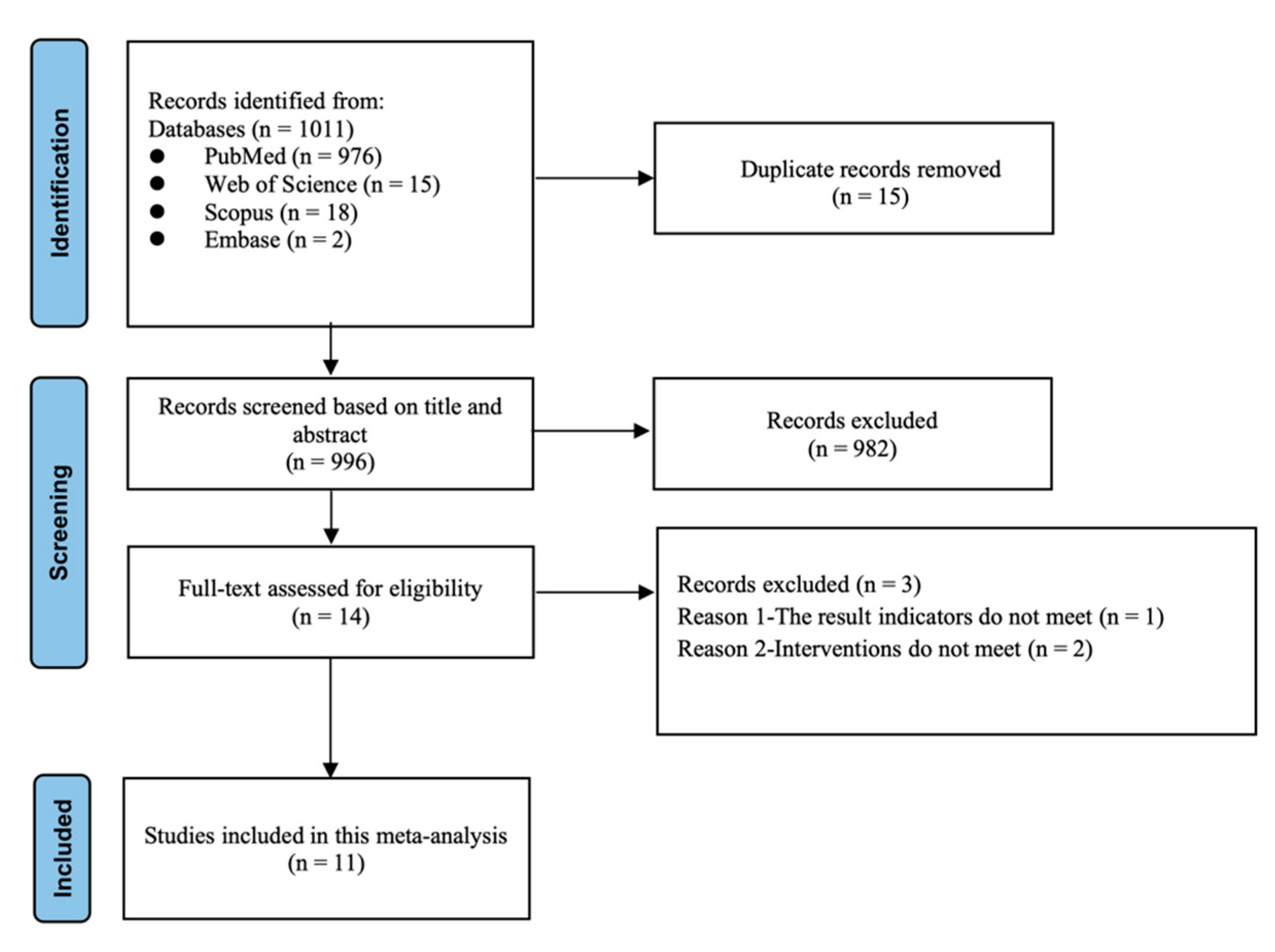
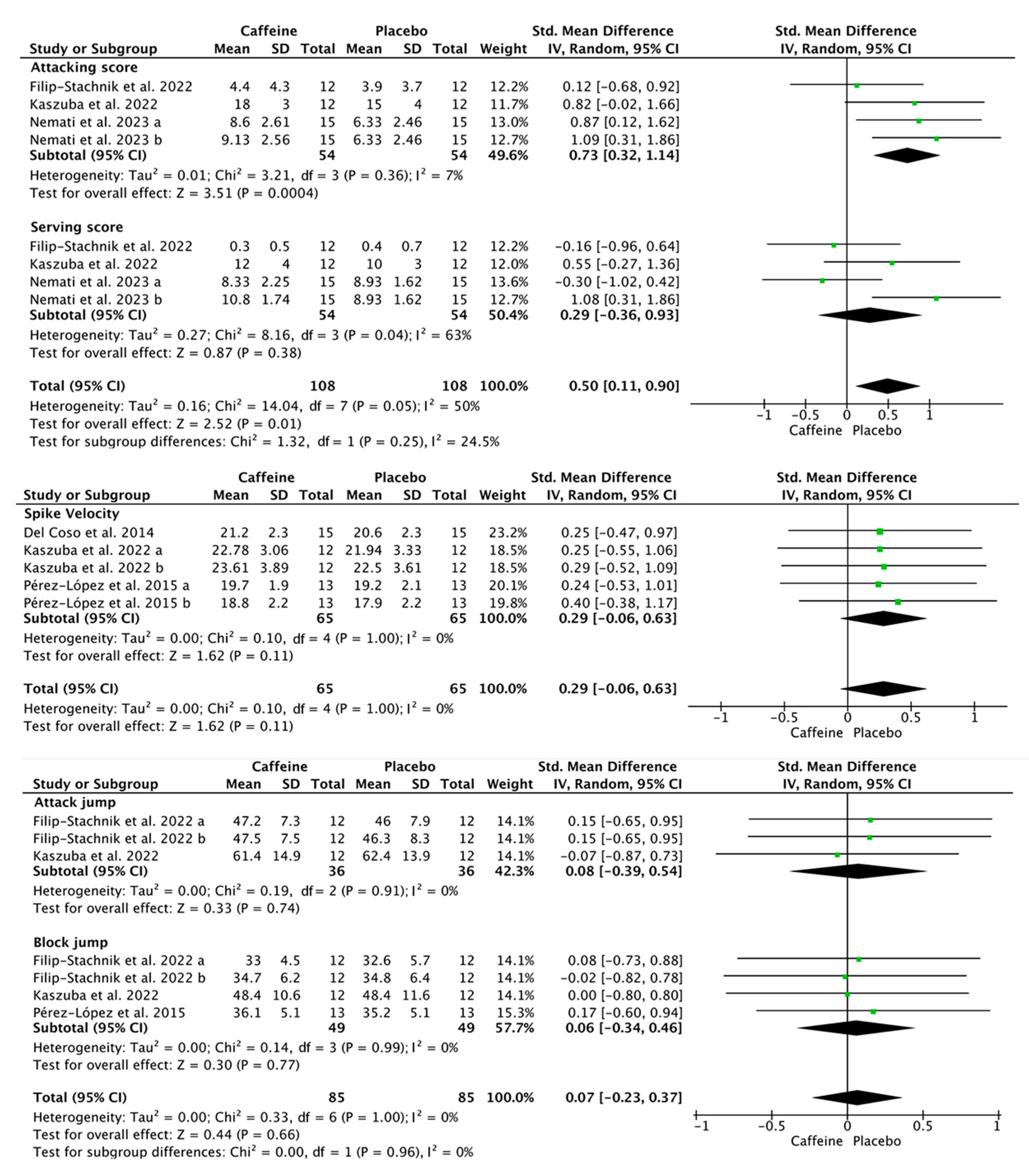
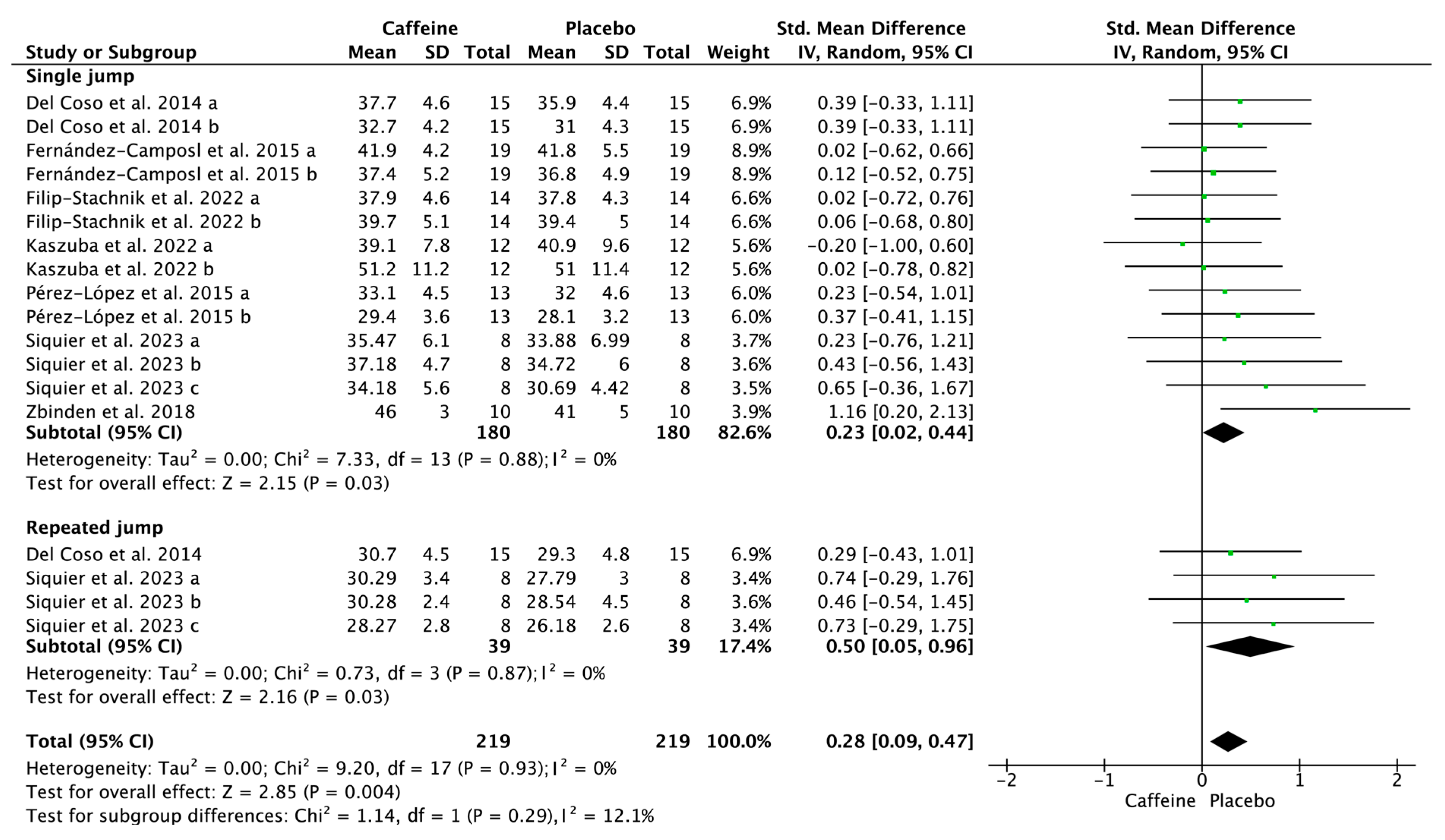
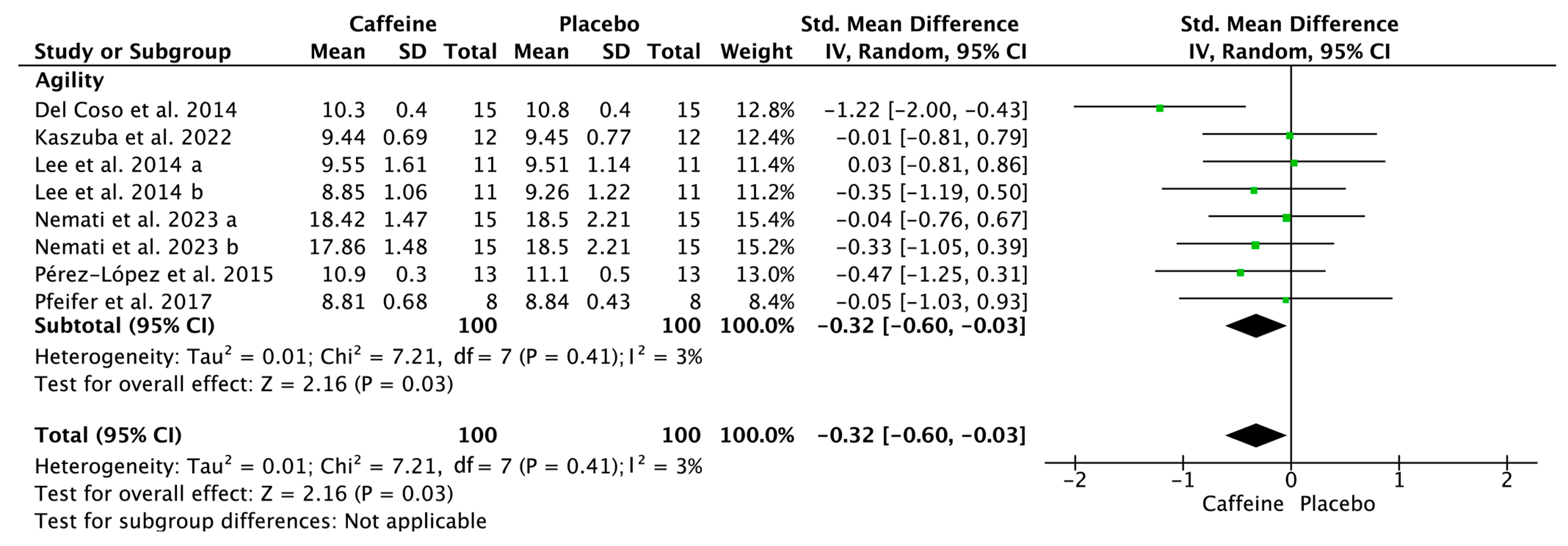
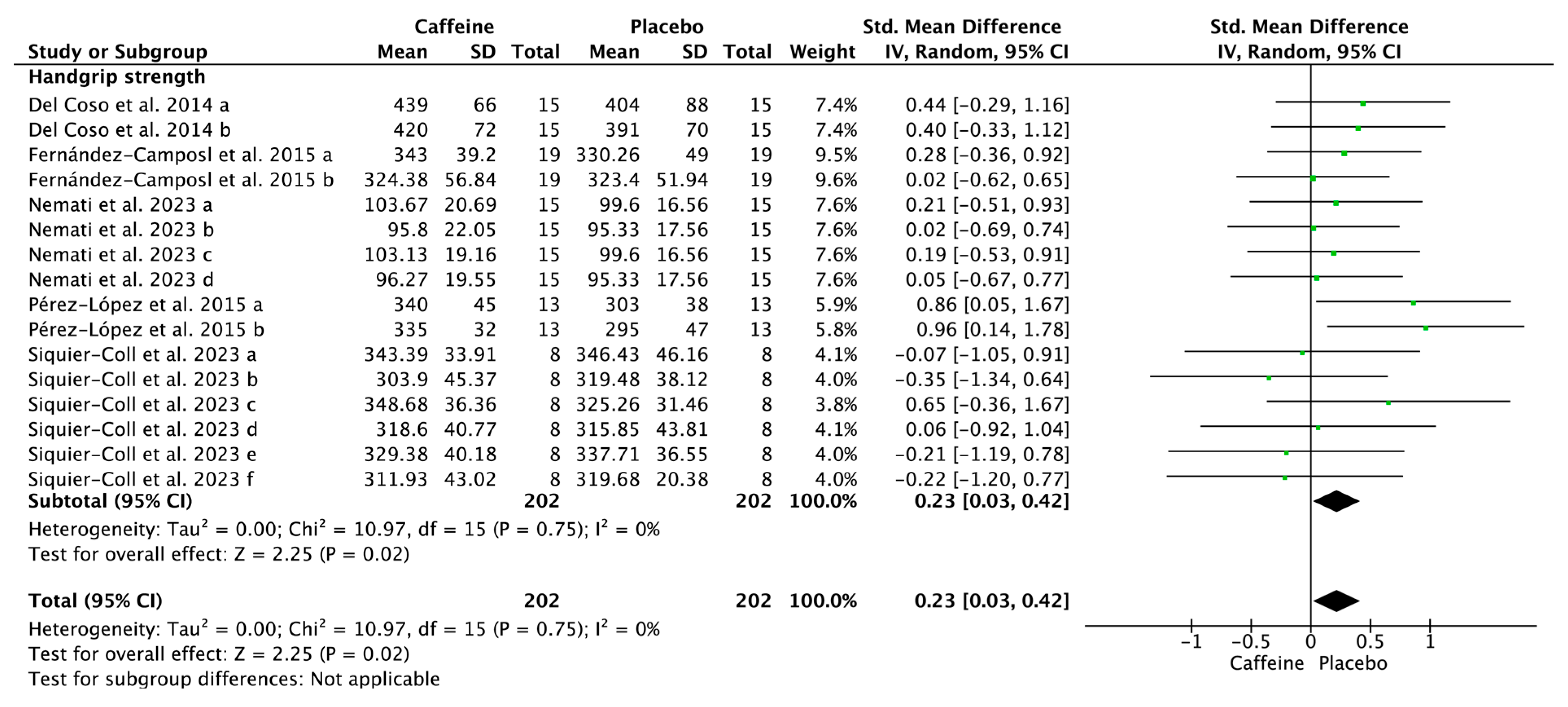

| Parameter | Inclusion Criteria |
|---|---|
| Participant | Volleyball players aged ≥ 18 years |
| Intervention | Caffeine supplementation (i.e., capsules, gum, powder, and caffeinated beverages), provided the effect of caffeine could be isolated. |
| Comparator | Placebo supplementation |
| Outcomes | Volleyball-specific tests: spike-ball velocity (standing and jumping); attacking and serving accuracy; and block and attack jumps. Nonspecific tests: single and repeated jumps; handgrip strength; and agility. Game actions during real or simulated competition: frequencies of positive; neutral; and negative game actions. |
| Study Design | Randomized single- or double-blind crossover designs. Only studies that were published in English and as original research (i.e., not a conference abstract or review) were included. |
| Study | Sample + Age (years) + Level | Habitual Caffeine Intake (mg/day) | Caffeine Form + Does (mg/kg or mg) + Timing (min) | Comparator | Exercise Protocol | Main Findings |
|---|---|---|---|---|---|---|
| Lee et al. (2014) [33] | 11 F; 21 ± 1; Elite | 75 | Capsule; 6; 60 | Placebo (cellulose) | AG test + RSE (5 × 4 s) | →AG: (Caffeine: 8.9 ± 1.1 vs. Placebo: 9.3 ± 1.2) |
| Del Coso et al. (2014) [34] | 15 M; 22 ± 6; Highly Trained | 30 | Energy drink; ~3 (239); 60 | Placebo (decaffeinated drink) | VS + CMJ + SJ + RJ + AG+ HS + SM test | ↑VS: +2.9% (21.2 ± 2.3 vs. 20.6 ± 2.3); Positive game actions: +36.0% (0.3 ± 0.2 vs. 0.3 ± 0.1); Negative game actions: +4.2% (0.3 ± 0.1 vs. 0.2 ± 0.1); CMJ: +5.0% (37.7 ± 4.6 vs. 35.9 ± 4.4); SJ: +5.5% (32.7 ± 4.2 vs. 31 ± 4.3); RJ: +4.8% (30.7 ± 4.5 vs. 29.3 ± 4.8); HS: +8.7% (439.0 ± 66.0 vs. 404.0 ± 88.0) ↓Positive game actions: −19.6% (0.4 ± 0.1 vs. 0.5 ± 0.1); AG: −4.6% (10.3 ± 0.4 vs. 10.8 ± 0.4) |
| Fernández et al. (2015) [35] | 19 F; 22 ± 4; Elite | N.A. | Energy drink; 2; 30 | Placebo (decaffeinated drink) | CMJ + SJ + HS test | →CMJ: (41.9 ± 4.2 vs. 41.8 ± 5.5); SJ: (37.4 ± 5.2 vs. 36.8 ± 4.9); HS: (324.4 ± 56.8 vs. 323.4 ± 51.9). ↑HS: +3.9% (343.0 ± 39.2 vs. 330.3 ± 49.0) |
| Pérez-López et al. (2015) [25] | 13 F; 25 ± 4; Highly Trained | N.A. | Energy drink; 3; 60 | Placebo (decaffeinated drink) | VS + SM test | ↑Spike ball velocity: +5.0% (18.8 ± 2.2 vs. 17.9 ± 2.2); Block jump height: +2.6% (36.1 ± 5.1 vs. 35.2 ± 5.1); Positive game actions: +32.4% (0.5 ± 0.1 vs. 0.3 ± 0.1); CMJ: +3.4% (33.1 ± 4.5 vs. 32 ± 4.6); SJ: +4.6% (29.4 ± 3.6 vs. 28.1 ± 3.2); HS: +13.6% (335.0 ± 32.0 vs. 295.0 ± 47.0) ↓Negative game actions: −50.0% (0.1 ± 0.1 vs. 0.3 ± 0.1); AG: −1.8% (10.9 ± 0.3 vs. 11.1 ± 0.5) →Neutral game actions: (0.4 ± 0.1 vs. 0.4 ± 0.1) |
| Pfeifer et al. (2017) [26] | 8 F; 20 ± 2; Highly Trained | N.A. | Power bar; ~1 (100); Before the match and each set | Placebo (decaffeinated gel) | SM + VJ + AG+ RS (30 m) test | →AG: (8.8 ± 0.7 vs. 8.8 ± 0.4) |
| Zbinden et al. (2018) [27] | 10 M; 19 ± 2; Elite | 60 | Capsule; 5; 60 | Placebo (dextrose) | CMJ test | ↑CMJ: +12.2% (46.0 ± 3.0 vs. 41.0 ± 5.0) |
| Filip-Stachnik et al. (2022) [28] | 12 F; 20 ± 2; Elite | 186 | Gum; ~6 (400); 15 | Placebo (cellulose) | VS + SM test | ↑Attack jump height: +2.6% (47.2 ± 7.3 vs. 46.0 ± 7.9) ↓Block jump height: −0.3% (34.7 ± 6.2 vs. 34.8 ± 6.4) →Attack point: (4.4 ± 4.3 vs. 3.9 ± 3.7); Serve point: (0.3 ± 0.5 vs. 0.4 ± 0.7) |
| Filip-Stachnik et al. (2022) [29] | 14 F; 26 ± 2; Elite | 181 | Capsule; 6; 60 | Placebo (flour) | CMJ test | →CMJ: (37.9 ± 4.6 vs. 37.8 ± 4.3) |
| Kaszuba et al. (2022) [30] | 9 M/3 F; 23 ± 3; Elite | 231 | Gum; ~3 (300 for M and 200 for F); 60 | Placebo (decaffeinated gum) | VS+ CMJ + SJ + AG + ST (30 m) test | ↑Attack accuracy: +20.0% (18.0 ± 3.0 vs. 15.0 ± 4.0) →Serve accuracy: (12.0 ± 4.0 vs. 10.0 ± 3.0); Attack accuracy: (23.6 ± 3.9 vs. 22.5 ± 3.6); Attack jump: (61.4 ± 14.9 vs. 62.4 ± 13.9); Block jump: (48.4 ± 10.6 vs. 48.4 ± 11.6); CMJ: (51.2 ± 11.2 vs. 51.0 ± 11.4); SJ: (39.1 ± 7.8 vs. 40.9 ± 9.6); AG: (9.4 ± 0.7 vs. 9.5 ± 0.8) |
| Nemati et al. (2023) [31] | 15 M; 20 ± 1; Highly Trained | N.A. | Capsule; 3 or 6; 60 | Placebo (starch) | VST + Sargent’s Jump + AG+ HS + MBTT +PT test | ↑Attack point: +44.2% (9.1 ± 2.6 vs. 6.3 ± 2.5); Serve point: +20.9% (10.8 ± 1.7 vs. 8.9 ± 1.6) →AG: (18.4 ± 1.5 vs. 18.5 ± 2.2) |
| Siquier-Coll et al. (2023) [32] | 8 F; 21 ± 4; Highly Trained | 100 | Powder; 5; 60 | Placebo (maltodextrin) | WQ + CMJ + RJ + COD 505 + Yo-Yo test | ↑CMJ: +11.4% (34.2 ± 5.6 vs. 30.7 ± 4.4); RJ: +9% (30.3 ± 3.4 vs. 27.8 ± 3.0); HS: +7.2% (348.7 ± 36.4 vs. 325.3 ± 31.5) |
Disclaimer/Publisher’s Note: The statements, opinions and data contained in all publications are solely those of the individual author(s) and contributor(s) and not of MDPI and/or the editor(s). MDPI and/or the editor(s) disclaim responsibility for any injury to people or property resulting from any ideas, methods, instructions or products referred to in the content. |
© 2025 by the authors. Licensee MDPI, Basel, Switzerland. This article is an open access article distributed under the terms and conditions of the Creative Commons Attribution (CC BY) license (https://creativecommons.org/licenses/by/4.0/).
Share and Cite
Chen, B.; Zhang, C.; Xu, Z.; Li, Y.; Guo, L.; Cao, Y.; Girard, O. Effects of Caffeine Supplementation on Exercise Performance in Volleyball Players: A Systematic Review and Meta-Analysis. Nutrients 2025, 17, 1709. https://doi.org/10.3390/nu17101709
Chen B, Zhang C, Xu Z, Li Y, Guo L, Cao Y, Girard O. Effects of Caffeine Supplementation on Exercise Performance in Volleyball Players: A Systematic Review and Meta-Analysis. Nutrients. 2025; 17(10):1709. https://doi.org/10.3390/nu17101709
Chicago/Turabian StyleChen, Bin, Chuanmin Zhang, Zhenghong Xu, Yiqian Li, Li Guo, Yinhang Cao, and Olivier Girard. 2025. "Effects of Caffeine Supplementation on Exercise Performance in Volleyball Players: A Systematic Review and Meta-Analysis" Nutrients 17, no. 10: 1709. https://doi.org/10.3390/nu17101709
APA StyleChen, B., Zhang, C., Xu, Z., Li, Y., Guo, L., Cao, Y., & Girard, O. (2025). Effects of Caffeine Supplementation on Exercise Performance in Volleyball Players: A Systematic Review and Meta-Analysis. Nutrients, 17(10), 1709. https://doi.org/10.3390/nu17101709





